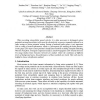Free Online Productivity Tools
i2Speak
i2Symbol
i2OCR
iTex2Img
iWeb2Print
iWeb2Shot
i2Type
iPdf2Split
iPdf2Merge
i2Bopomofo
i2Arabic
i2Style
i2Image
i2PDF
iLatex2Rtf
Sci2ools
FGCN
2008
IEEE
2008
IEEE
Experimental Study on Neuronal Spike Sorting Methods
When recording extracellular neural activity, it is often necessary to distinguish action potentials arising from distinct cells near the electrode tip, a process commonly referred to as spike sorting or action potential sorting. Sorting of neuronal spikes plays a very important role in coding of neural information, which is a prerequisite for studying the brain function. In this paper, five major action potential classification methods including Template Matching, Wavelet Transform, Principal Component Analysis, Back-Propagation (BP) Neural Network, Two-stage Radius Basis Function Network are studied. Under the conditions of different levels of background noise, the performances of these methods are tested. This work may be helpful to choose classification method.
Action Potential | Classification Method | Communications | Extracellular Neural Activity | FGCN 2008 |
| Added | 29 May 2010 |
| Updated | 29 May 2010 |
| Type | Conference |
| Year | 2008 |
| Where | FGCN |
| Authors | Jianhua Dai, Xiaochun Liu, Yu Yi, Huaijian Zhang, Jingjing Wang, Shaomin Zhang, Xiaoxiang Zheng |
Comments (0)

